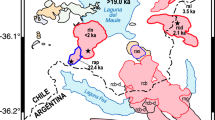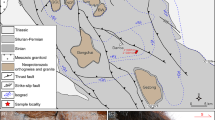Abstract
The topography of various faces of quartz crystals indicates that the late growth of rock crystals occurred at a relatively slow rate, by the layer by layer mechanism activated by screw dislocations. The capture mechanism of gas-liquid inclusions by quartz at the deposit is identified, and gas-liquid and solid inclusions are examined in various quartz populations. The temperature of the mineral-forming processes is evaluated from the homogenization temperatures of the inclusions. Distinct quartz populations are determined to be formed under similar physicochemical conditions, at temperatures no higher than 260°C, which increased from earlier to later quartz populations. The quartz veins were produced by solutions of sodic-hydrocarbonate composition. The geochemical environment in which mineral-forming processes occurred at the Zhelannoe deposit was generally poor in fluid, and the inclusions are dominated by water and usually contain no more than 10 wt % carbon dioxide, strongly subordinated amounts of nitrogen and carbon monoxide, and no identifiable methane amounts.
Similar content being viewed by others
References
Sh. A. Evstropov, Yu. I. Bur’yan, N. M. Serykh, and S. S. Tsyutskii, Gangue Quartz of the Urals in Science and Technology. Geology of the Main Deposits of Quartz Raw Material (Nedra, Moscow, 1995) [in Russian].
S. K. Kuznetsov, Gangue Quarts of the Nether-Polar Urals (Nauka, St. Petersburg, 1998) [in Russian].
V. A. Smirnova and E. A. Konstantinov, “Block Tectonics and Crystal Potential,” in Geology, Search, and Prospecting of Non-Ore Minerals (Leningrad, 1977), No. 3, pp. 42–47 [in Russian].
A. E. Karyakin, “Host Rocks as a Source of Material for Minerals from Quartz Crystal Pockets,” Zap. Leningr. Gorn. Inst. 30(2), 118–144 (1955) [in Russian].
A. V. Kozlov, Extended Abstract of Candidate’s Dissertation in Geology and Mineralogy (Leningrad, 1974) [in Russian].
A. V. Kozlov, Extended Abstract of Doctoral Dissertation in Geology and Mineralogy (St. Petersburg, 1998).
A. V. Kozlov, B. N. Sharonov, and D. V. Nikitin, “Specifics of Manifestation of Mineral Formation at a Deposits of Quartz Crystals in the Nether-Polar Urals,” in Geology and Exploration for Nonore Minerals (Moscow, 1977), No. 3, pp. 34–40 [in Russian].
V. G. Portnov and S. V. Bukatich, “Tectonic Conditions of the Formation of Quartz Veins and Quartz Crystal-Bearing Pockets of One Piezoelectric Quartz Deposit in the Quartzites of the Polar Urals,” in Geology and Minerals of the Northeastern Part of the USSR and the Northern Urals (Syktyvkar, 1973), pp. 491–496 [in Russian].
A. A. Chernov, “Layer-Spiral Growth of Crystals,” Usp. Fiz. Nauk 73(2), 292 (1961).
A. M. Askhabov, “Clusters of a Hidden Phase (Quatrons) as Building Units during the Growth of Crystals from Solution,” in Physics of Crystallization (Nauka, Moscow, 2002), pp. 37–42 [in Russian].
F. Mirzoev and L. A. Shelepin, “The Role of Nanoclusters of a Crystallizing Component in the Bulk Crystallization Process,” Pis’ma Zh. Tekh. Fiz. 28(1), 15–22 (2002) [Tech. Phys. Lett. 28, 6–9 (2002)].
P. J. Heaney, “Estimated Mechanism of the Chalcedony Growth,” Contrib. Mineral. Petrol. 115, 66–74 (1993).
A. V. Piznyur, “Some Notes on the Character of Mineral-Forming Solutions during Development of Quartz Crystal-Bearing Veins of the Nether-Polar Urals,” Zap. Vses. Mineral. O-va 88(4), 474–476 (1959).
Yu. A. Tkachev and A. I. Punegov, Separation of a Distribution Mixture into Two Normal Components (Geoprint, Syktyvkar, 1986) [in Russian].
A. A. Korago and V. S. Aplonov, “Composition of Aqueous Leachates from Quartz from the Nether-Polar Urals,” Geokhimiya, 685–692 (1987).
D.G. Pal’mova, L.A. Kopneva, P.A. Ivanov, and A. M. Prusakov, “Physicochemical Characteristics of the Gold-Bearing Solutions,” in Theory and Practice of Studying Inclusions in Minerals (Nauka, Moscow, 1978), pp. 101–106 [in Russian].
G. N. Vertushkov, “Metamorphism of Gangue Quartz,” Tr. Sverdlovsk. Gorn. Inst. 22, 193–202 (1955).
Author information
Authors and Affiliations
Corresponding author
Additional information
Original Russian Text © N.V. Sokerina, N.N. Piskunova, 2011, published in Geokhimiya, 2011, Vol. 49, No. 2, pp. 192–202.
Rights and permissions
About this article
Cite this article
Sokerina, N.V., Piskunova, N.N. Growth condition of quartz crystals at the Zhelannoe deposit in the Nether-Polar Urals: Evidence from fluid and solid inclusions. Geochem. Int. 49, 181–190 (2011). https://doi.org/10.1134/S0016702911020091
Received:
Published:
Issue Date:
DOI: https://doi.org/10.1134/S0016702911020091




